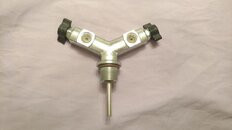Back to the actual discussion of DD's incident, my earlier post started me thinking.
Wouldn't it have been smarter for DD to shut down his tank valve immediately, rather than continuing to breathe it until it ran out? Or, possibly, inject some gas in his BCD, to get a little positive and start his ascent, and then shut it down. Either way (it's only maybe 2 seconds difference), the point being not to leave it open until it ran out.
Example:
- hear reg blow
- grab inflator, push button and hold it down
- immediately begin valve shutdown
- once valve is shut, release inflator button
- grab pony reg and prepare to exchange
- if you still hear bubbles, then you know it's a blown tank valve O-ring, so re-open the tank valve and keep breathing off the tank until it's empty. No point in letting Neptune have ALL that gas. Conserve the pony bottle, in this case.
- if the bubbles have stopped, 2nd stage in mouth should already be breathed out because of holding down the inflator button
- exchange regs immediately (if bubbles stopped)
- return hand to inflator and begin to vent to control ascent
- stop at 15'. If pony runs out, start feathering the tank valve and breathing off that (assuming there's any gas left)
If he was neutral when it blew, maybe the inflator part is optional. A little bit of a swim up and he'd be positive anyway.
I'm thinking that with the cool-under-pressure that DD displayed this whole process would be complete in 4 seconds or less. Assuming he can reach his tank valve, of course. So, he would easily be positively buoyant but preventing himself from corking all the way to the surface. And he would get to safety stop depth still with most of his gas in the tank (assuming it was a blown HP seat and not a blown tank valve O-ring).




